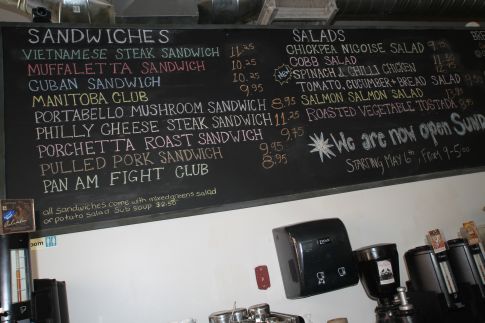 Nestled on a corner in Winnipeg’s Exchange District, is the renowned Winnipeg Free Press Cafe on McDermot Avenue. It has become a social hub and meeting place where people perform, celebrities pass through and media personalities hang out.
Nestled on a corner in Winnipeg’s Exchange District, is the renowned Winnipeg Free Press Cafe on McDermot Avenue. It has become a social hub and meeting place where people perform, celebrities pass through and media personalities hang out.
They live-stream a variety of programs at the Café and host events like town halls, mini-concerts, book readings and more. You can meet journalists, as they rotate in a variety of editors, beat writers and columnists week after week. 
Noted local restaurateur Domenic Amatuzio – behind such culinary delights as Terrace Fifty Five, Civita and the Liberty Grill – has come up with their menu.
From the day the first edition rolled off the presses in 1872, the Winnipeg Free Press has been an integral part of the city and province it serves. It is a position the newspaper is certain to maintain in the new millennium.
There’s a whole lotta history behind the paper, which adds to the continued support of the Winnipeg Free Press newspaper and the cafe.
Part of the Free Press’ success can be attributed to the fact that it is only two years younger than the province of Manitoba, which joined Confederation in 1870, and actually two years older than the City of Winnipeg, which was incorporated in 1874. This means that the newspaper has been around as long as the community itself, faithfully recording the growth and development of a muddy Prairie settlement at the forks of the Red and Assiniboine Rivers into one of Canada’s leading cities.
Despite the fact that newspapers are dying off, there’s nostalgia for it in Winnipeg. Over the years, the newspaper has gained a reputation as the province’s leading source of news, information and debate about local matters and ideas, as well as Manitoba’s voice on national and international issues.

On the left is Sir Clifford Sifton, the western patriarch, federal cabinet minister, and owner of the Free Press at the turn of the century. It is a reputation that can be traced back to the original owner and editor of the Free Press, W.F. Luxton, and his partner John A. Kenny. Together, these men launched a newspaper that was to grow into a formidable journalistic and commercial force and serve as the linchpin for a national chain of newspapers stretching across much of the country.
A l’il history about its beginnings from the Winnipeg Free Press website:
“With a population of 1,467, the Winnipeg of 1872 was the largest of several budding communities in Manitoba at a time when the future was as wide open and bright as the blue Prairie sky. Yet its future was by no means assured. By late 1880, the recently incorporated City of Winnipeg found itself in a competition with the nearby communities of Selkirk and Emerson for the new railroad that was being built across the country. After some debate, Winnipeg was eventually selected as the site, forever assuring the community’s place as the province’s leading city and providing the Free Press with a source of readers that would help make it one of the most important newspapers in the country.
By the turn of the century, Manitoba had become an important player on the national scene. The railroad had helped bring hundreds of thousands of settlers to the Prairies, making Winnipeg a boomtown and the most important city in the West. And as the city became more important in local and national affairs, so did the Free Press.
In retrospect, it is clear that two developments at this time were crucial to the continued success of the Free Press and its eventual development as one of Canada’s great newspapers. One was the acquisition of the newspaper by Sir Clifford Sifton, a man who distinguished himself as a powerful cabinet minister in the government of Sir Wilfrid Laurier and would be remembered as one of the patriarchs of Western Canada. The other was Sifton’s decision to hire John W. Dafoe as editor of the newspaper and E.H.. Macklin as its chief business manager. Together, these three men provided the Free Press with the journalistic and commercial leadership required to outlast its competitors and maintain its position as the largest selling newspaper in Manitoba.
It was during these years that the Free Press cemented its reputation as the leading voice of Western Canada, thanks in large measure to the talents of John Dafoe. Writing on the editorial page of the Free Press Dafoe consistently and elegantly put forward the case for Western Canadian interests. He supported the drive to reduce tariffs and the attempt to strike a reciprocity treaty with the United States, launched a campaign to strengthen Canadian autonomy from Britain and was a central figure in drumming up support for conscription and the formation of Sir Robert Borden’s union government during the First World War.”
Today’s Free Press is very different from the one published by Luxton and Kenny more than a century ago. The Winnipeg Free Press Cafe remains a bustling hub for gatherings and is located in the funky area of town called the Exchange District, my favorite part of town.
Below is a glimpse at the Winnipeg Free Press Cafe today, taken when I was visiting the city in late August.

Renee Blodgett is the founder of We Blog the World. The site combines the magic of an online culture and travel magazine with a global blog network and has contributors from every continent in the world. Having lived in 10 countries and explored nearly 80, she is an avid traveler, and a lover, observer and participant in cultural diversity.
She is also the CEO and founder of Magic Sauce Media, a new media services consultancy focused on viral marketing, social media, branding, events and PR. For over 20 years, she has helped companies from 12 countries get traction in the market. Known for her global and organic approach to product and corporate launches, Renee practices what she pitches and as an active user of social media, she helps clients navigate digital waters from around the world. Renee has been blogging for over 16 years and regularly writes on her personal blog Down the Avenue, Huffington Post, BlogHer, We Blog the World and other sites. She was ranked #12 Social Media Influencer by Forbes Magazine and is listed as a new media influencer and game changer on various sites and books on the new media revolution. In 2013, she was listed as the 6th most influential woman in social media by Forbes Magazine on a Top 20 List.
Her passion for art, storytelling and photography led to the launch of Magic Sauce Photography, which is a visual extension of her writing, the result of which has led to producing six photo books: Galapagos Islands, London, South Africa, Rome, Urbanization and Ecuador.
Renee is also the co-founder of Traveling Geeks, an initiative that brings entrepreneurs, thought leaders, bloggers, creators, curators and influencers to other countries to share and learn from peers, governments, corporations, and the general public in order to educate, share, evaluate, and promote innovative technologies.











